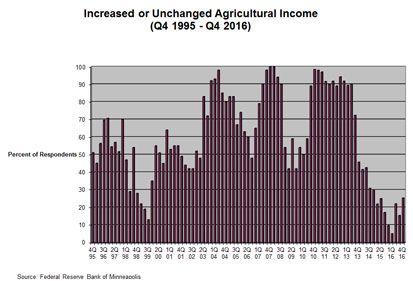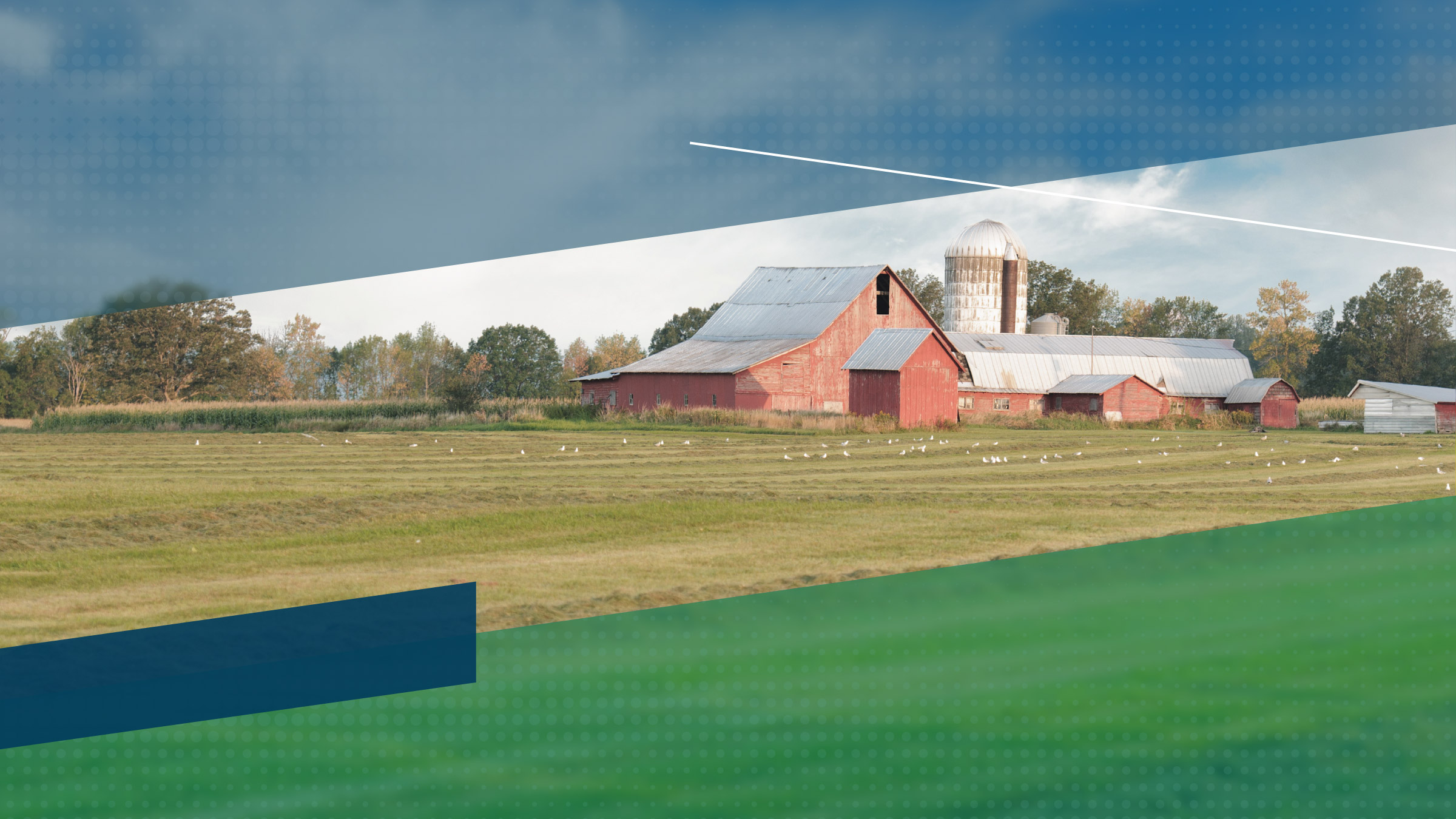Farmers in most areas of the Ninth District saw good yields in 2016, and for another year those strong harvests should offset some of the effect of continued low crop prices. Farm incomes and capital spending continued to decrease, according to lenders responding to the Minneapolis Fed’s fourth-quarter (January) agricultural credit conditions survey. Falling incomes also led to decreased loan repayment rates, while loan demand, renewals and extensions increased. The rapid growth of farmland values and rents continued to decline from record levels of a few years ago. The outlook for the first quarter of 2017 is modest, with survey respondents predicting a mild decline in incomes, capital expenditures and household spending.
Farm income, household spending and capital investment
A Minnesota banker summed up the year for farm incomes: “Those extra bushels really helped this year.” The trend of falling farm incomes continued, but eased somewhat from the third quarter. Three-quarters of lenders said that farm income decreased in the fourth quarter compared with a year earlier, while only 3 percent reported increases. While 10 percent of North Dakota lenders reported increased income, the highest proportion in any district state, nearly two-thirds said incomes decreased. As indicated by expectations from the previous survey, 86 percent of lenders said capital spending by agricultural producers fell in the fourth quarter and another 13 percent reported that it was flat. Farm household was also down, with 58 percent of respondents reporting decreases and 39 percent indicating it was unchanged.

Loan repayments and renewals
Consistent with weak incomes, loan repayment rates decreased, while renewals ticked up. “Most customers are coming in with earned net worth losses and reductions in working capital. We’re doing consolidations and restructures on several,” wrote a South Dakota lender. About 55 percent of the lenders responding to the survey reported a lower rate of loan repayment from a year earlier, while 44 percent reported that they held steady. Half of lenders reported no change in the number of loan renewals or extensions, while 47 percent noted that renewal activity increased.
Demand for loans, required collateral and interest rates
Loan demand was up; 42 percent of respondents said demand increased from the last quarter of 2015, while 55 percent noted no change. This was generally consistent across district states. While a strong majority of lenders reported no change in collateral requirements on loans, about a fifth said they increased. Fixed and variable interest rates on loans for operating, machinery and real-estate increased slightly from their third-quarter levels.
Cash rents and land values
As in other recent quarterly surveys, farmland values continued to decrease somewhat in the final three months of 2016, with cash rents following suit. Average land values and cash rents for nonirrigated land, irrigated land and ranchland all fell from the previous year districtwide. Nonirrigated farmland saw the biggest drop, with the district average value decreasing 5.4 percent, while rents fell 6.6 percent over last year. Decreases for irrigated farmland and ranchland were similar, with values down 4.3 percent and 5 percent, respectively, while rents fell 8.4 percent and 0.5 percent.
Outlook
In keeping with current conditions, expectations for the first quarter of this year are modest, though less dire than recent quarters. “Rents are beginning to come down, as well as certain inputs. 2017 cash flows look reasonable,” a Minnesota banker wrote, capturing the sentiment: Almost 60 percent of lenders responding to the survey predict that farm income will continue to decrease in the first quarter of 2017, and about half expect capital spending to fall. Perhaps a bigger surprise, given the recent trend of declining farm incomes, is that more than a third expect incomes to hold steady. Respondents were more pessimistic about household spending, as almost three-quarters expect decreases. Lenders also expect loan demand to increase and repayment rates to decline on balance, while they expect renewals and collateral requirements to increase.
Percent of respondents who reported decreased levels for the past three months compared with the same period last year:
|
MN |
MT |
ND |
SD |
WI |
Ninth District |
|
| Rate of loan repayments |
62
|
60
|
43
|
58
|
60
|
55
|
| Net farm income |
76
|
100
|
62
|
74
|
100
|
75
|
| Farm household spending |
57
|
40
|
55
|
63
|
75
|
58
|
| Farm capital spending |
86
|
100
|
81
|
89
|
80
|
86
|
| Loan demand |
5
|
-
|
-
|
5
|
-
|
3
|
Percent of respondents who reported increased levels for the past three months compared with the same period last year:
|
MN |
MT |
ND |
SD |
WI |
Ninth District |
|
| Loan renewals or extensions |
48
|
80
|
43
|
37
|
60
|
46
|
| Referrals to other lenders |
10
|
-
|
16
|
32
|
20
|
17
|
| Amount of collateral required |
19
|
-
|
14
|
32
|
20
|
20
|
| Loan demand |
38
|
40
|
43
|
42
|
60
|
42
|
Percent of respondents who expect decreased levels for the next three months:
|
MN |
MT |
ND |
SD |
WI |
Ninth District |
|
| Rate of loan repayments |
60
|
60
|
40
|
56
|
50
|
52
|
| Net farm income |
67
|
80
|
48
|
63
|
40
|
59
|
| Farm household spending |
52
|
60
|
43
|
53
|
40
|
49
|
| Farm capital spending |
81
|
80
|
60
|
89
|
40
|
74
|
| Loan demand |
5
|
-
|
5
|
6
|
-
|
4
|
Percent of respondents who expect increased levels for the next three months:
|
MN |
MT |
ND |
SD |
WI |
Ninth District |
|
| Loan renewals or extensions |
50
|
80
|
55
|
39
|
50
|
51
|
| Referrals to other lenders |
21
|
-
|
17
|
18
|
25
|
17
|
| Amount of collateral required |
26
|
-
|
30
|
17
|
-
|
21
|
| Loan demand |
35
|
60
|
55
|
50
|
75
|
49
|
Note: The Upper Peninsula of Michigan is not part of the survey.
Appendix:
Joe Mahon is a Minneapolis Fed regional outreach director. Joe’s primary responsibilities involve tracking several sectors of the Ninth District economy, including agriculture, manufacturing, energy, and mining.





